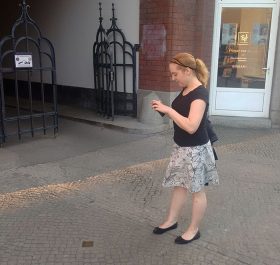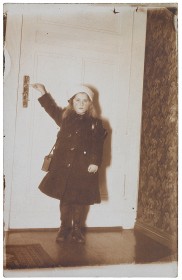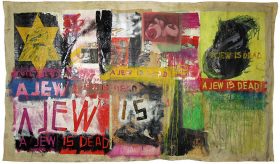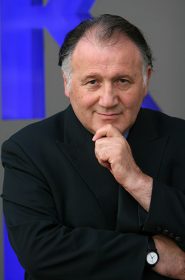Our Project on the Topography of Jewish Life in Germany

Stumbling stone in remembrance of Editha Machol in Yorkstraße 88 in Berlin-Kreuzberg; Jewish Museum Berlin
“I was playing Hans-Jürgen for you again,” my father said gleefully when he called me over Whit Weekend. Hans-Jürgen is 68, a retired teacher, and interested in regional Jewish history. My father, however, is not a retired teacher and his name is actually Rudi, but he had displayed what one could call Hans-Jürgenesque behavior: he participated in a public tour of a Jewish cemetery in his hometown, recorded his impressions with a camera, and sent them to us in Berlin. For Hans-Jürgen doesn’t really exist: he’s just a fictitious person we used in order to develop a prototype – a kind of pre-testing version – for a cartographic app. This prototype is the foundation for the online portal, which we at the Jewish Museum Berlin want to complete construction on in the next two years. The goal is to gather – all in one place, for the first time – comprehensive geographical information on Jewish life in Germany and make it accessible online in an interactive map. → continue reading
A Photo Collection Found Hiding in Berlin-Friedrichshain

A girl standing in front of a door, presumably Berlin, about 1918–1922; Jewish Museum Berlin
Every time I open a new folder of photos, I can’t know what’s waiting for me – what faces I’ll find or fates will be revealed. Images are often part of a larger collection, consisting of documents, everyday articles and artwork, for which we already know the biographies of those pictured or can further research. Such was the case, for example, of the cabaret artist, Olga Irén Fröhlich, whom I’ve written about before on this blog. This time, however, the people in the photographs will remain unknown to me; I won’t be able to attach names or histories to them. Perhaps you can!
It’s not out of the ordinary to work with collections that have been in the Museum’s possession for decades. → continue reading
A Conversation with Peter Weibel about whether Boris Lurie Should Be Seen as a Part of the Ultra-realist Neo-avant-garde, and Pornography as a Metaphor for Capitalist Society

Boris Lurie, “A Jew is dead,” 1964; Boris Lurie Art Foundation, New York, USA
Mirjam Bitter, blog editor: As part of the program accompanying our Boris Lurie retrospective, you’ll be giving a lecture at the Jewish Museum Berlin on 30 May 2016 on the subject of “The Holocaust and the Problem of Visual Representation,” (further details of which can be found in our events calendar). Is this tied up with the idea that the Holocaust is a major theme in Lurie’s work?

Peter Weibel
© ONUK
Peter Weibel: The Holocaust, along with war, Hiroshima, and Nagasaki were pivotal traumatic experiences for the post-Second World War neo-avant-garde. Take, for example, Yves Klein’s painting “Hiroshima” (1961) or Joseph Beuy’s environment “Show Your Wound” (1974–1975). Many artists responded to the inhumanity they had witnessed by calling into question humanity and indeed, civilization itself: Why, they asked, had literature, painting, music, and philosophy been unable to prevent this twentieth-century barbarism? → continue reading



